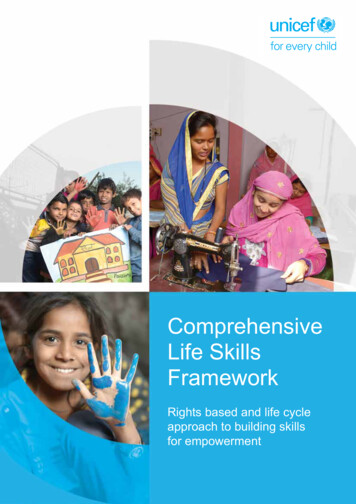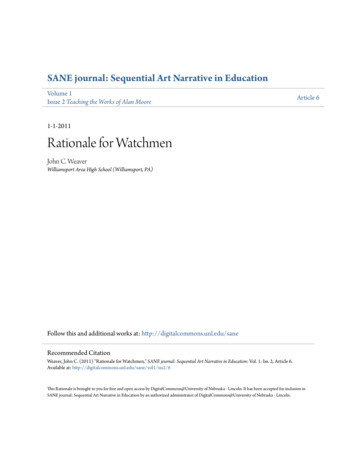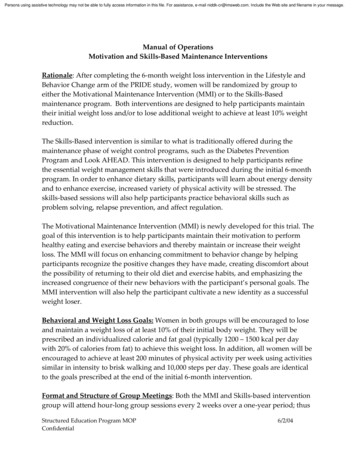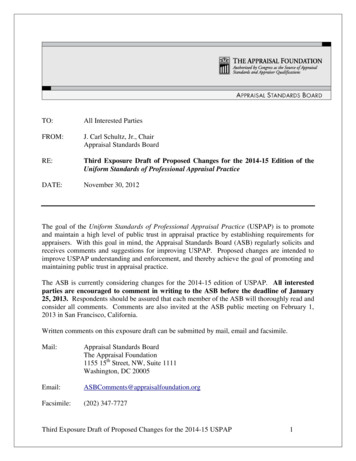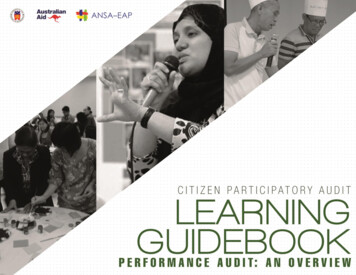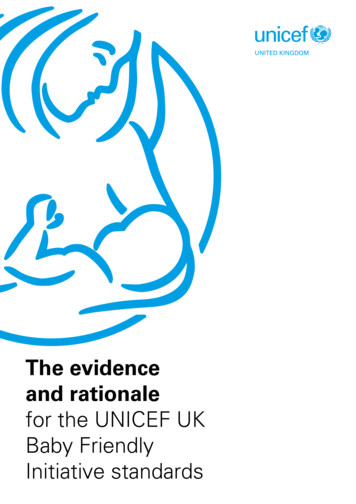
Transcription
The evidenceand rationalefor the UNICEF UKBaby FriendlyInitiative standards
UNICEF UK 2013This book and any additions or amends subsequent to printing are available at:unicef.org.uk/BFIevidence
The evidenceand rationalefor the UNICEF UKBaby FriendlyInitiative standards
ForewordsI was delighted to welcome the Baby Friendly Initiative’s new standards,published by UNICEF in 2012.When the 2010 Infant Feeding Survey was published last year, it brought welcomenews about breastfeeding rates: more women are starting to breastfeed, andmore women are breastfeeding for longer.This means that more women are getting the help they need to breastfeed,which reflects better care in maternity and community settings. Ultimately, morebreastfeeding is good for both mothers and babies.But we still want to see more increases in breastfeeding initiation and duration, and a greater focus onencouraging mothers to develop a strong, loving bond with their baby. Baby Friendly’s new standardssupport feeding and relationship-building for all mothers and babies, whether breastfeeding or bottlefeeding, recognising the importance of the mother-baby relationship as the basis on which all otherrelationships are built.And as we move forward and go even further in promoting these improvements, a solid evidence baseis crucial. This evidence book is supporting changes to practice that will help deliver better long-termoutcomes for mothers and babies.Improving the health and well-being of mothers and babies through promoting breastfeeding andbonding is an exciting prospect, and I commend this evidence book to all those who are working hard toachieve this goal.Dr Dan Poulter MPParliamentary Under Secretary of State for HealthMuch work has been undertaken in implementing the UNICEF UK Baby FriendlyInitiative programme in a range of settings across all Northern Ireland Health andSocial Care Trusts. This demonstrates a real commitment to promote and supportbest practice and shows the high respect in which BFI is held.While our rates of breastfeeding have significantly improved over the years,our rates are still low in comparison to the rest of the UK and other countries.We recognise that there is more to do.Our regional Breastfeeding Strategy, published this year, highlights the need formultifaceted approaches, improvements to hospital and community support,effective peer support programmes, protection from poor practices and public information campaigns toimprove awareness and social acceptability of breastfeeding.I welcome the revised BFI standards, which are underpinned by a robust evidence base and provide aframework to encourage and support health professionals and services to work together collaborativelyand effectively, to deliver the best outcomes for both mother and baby.This evidence book supports our commitment to improve breastfeeding rates and provide supportiveenvironments to enable mothers and families to establish close relationships and give their babies agood start in life.Edwin Poots MLAMinister for Health Social Services and Public Safety, Northern Ireland Executive4BABY FRIENDLY INITIATIVEEvidence and rationale
ForewordsThe Scottish Government is committed to ensuring that every child in Scotlandgets the best possible start in life. We know that breastfeeding makes a hugecontribution to the health and well-being of babies and mothers, which is why weare committed to its promotion and support throughout Scotland.Achievement of UNICEF UK Baby Friendly accreditation is an important elementof Improving Maternal and Infant Nutrition: A Framework for Action (ScottishGovernment, 2011). We have seen considerable progress in this, as 81 percent of babies in Scotland are now born in a BFI-accredited unit, with the aim ofincreasing this to 100 per cent by 2015. In 2012, NHS Greater Glasgow and Clydewas the first health authority in the United Kingdom to achieve BFI accreditation across all acute andcommunity services.I very much welcome the development of the new BFI standards, with their emphasis on strong parentand child bonds; as well as the introduction of standards for neonatal units, which will help support theaims of our recently launched Quality Framework for Neonatal Care. This evidence book will help providethe support needed for further progress to be made across Scotland.Michael Matheson MSPMinister for Public Health, Scottish GovernmentThe Welsh Government was proud to be the first UK country to welcome thenew UNICEF UK Baby Friendly Initiative standards, launched in Cardiff inDecember 2012.We endorse its emphasis on improving the quality of support for all expectant andnew parents; the focus on supporting strong parent-infant bonds; and continuedsupport for increasing breastfeeding rates.Here in Wales we have embraced the new neonatal breastfeeding standardsas part of our vision for health services.This important book gathers, in one place, the evidence behind the new standards. It will provideinvaluable support for practitioners, managers and leaders who are working to ensure that all children inWales have a bright future.Mark Drakeford AMMinister for Health and Social Services, Welsh Government5BABY FRIENDLY INITIATIVEEvidence and rationale
IntroductionIn 2012, I started on a journey to collate the evidence that hadbeen used to support the rationale for, and development of, thenew Baby Friendly Initiative standards – the result of which isthis book.Its aim is to bring together the considerable body of knowledgeand skills, research, practice and policy into one place. The workcritically analyses the available evidence and highlights bothgood practice and gaps in our information.I hope that the user-friendly format will inspire and motivateyou to use this evidence in your day to day work. I have beengiven the time to think, reflect and collate the information, worked with many of youand explored the narrative – the result of which is a resource to enable you to bettersupport women to provide the best nutrition and build a close and loving relationshipwith their baby.This book captures gold standard evidence presented in systematic reviews and metaanalyses of quantitative and qualitative research. Where these are not available, it hasdrawn on examples of good and emerging best practice. Case studies are used toinspire and motivate ideas for you to create meaningful change at an individual, culturaland societal level within your local community.I understand the challenges faced by those involved in infant feeding support: it can bedifficult to identify the evidence available, work out what is good quality, current andapplicable and then critically analyse how best to commission and apply it. I hope this bookwill go some way to addressing this, and that you will enjoy, quote, pick up and put down,come back to and use it again and again, in your everyday practice to inform your care.The new Baby Friendly Initiative standards have been developed based on the latestresearch. Evaluation of the standards is going to be required over time to analysewhether this new approach yields results. Understanding the evidence that underpinsthe standards is one thing, implementing them in a way that creates behavioural changeat an individual and societal level requires a co-ordinated approach by us all.I look forward to your feedback and adding to this body of evidence as new informationcomes to light. The future of this book’s success lies in it being a truly collaborativedocument, based on evidence and your experience. In this way, it will help us now, andin the future, to support mothers and babies in the best possible way.Francesca M Entwistle RN, RM, ADM, PGCEA, MSc by ResearchMidwifery Lecturer, University of Hertfordshiref.entwistle@herts.ac.uk6BABY FRIENDLY INITIATIVEEvidence and rationale
12Peer reviewers12National policy contribution12Abbreviations13Overview of the UNICEF UK Baby Friendly Initiative Standards14Chapter 1: Introduction and background16IntroductionAvailable evidence and rationale16Electronic searches17How to use this book17Background18Overview of why breastfeeding is important18Policy context – national and international20UK national policy20English national policy21Scottish national policy21Welsh national policy22Northern Irish national policy22Global policy24European policy25Breastfeeding initiation27Breastfeeding prevalence28Understanding breastfeeding data29Recording local data29The rationale for the review and updating of the Baby Friendly Initiative Standards34Reflections on the current BFI approach34Revised standards35Summary of the rationale for change36Chapter 2: Building a firm foundation37Introduction37Why policy development is important37Understanding the specific elements of a policy38Turning policy into practice, and practice into improved breastfeeding outcomes39Chapter 3: An educated workforce43Introduction437BABY FRIENDLY INITIATIVEEvidence and rationale
ContentsKnowledge, attitudes and practice of staff44The learning needs of health professionals to promote and support breastfeeding47Effectiveness of education programmes51Conclusion53Chapter 4: Parents’ experiences544.1. Standard 1: Support pregnant women to recognise the importanceof breastfeeding and early relationships on the health and well-being of their baby55Introduction55The role of antenatal education57Meaningful conversations59Information in pregnancy59Interventions to increase the initiation of breastfeeding60Conclusion614.2. Standard 2: Support all mothers and babies to initiate a closerelationship and feeding soon after birth.Introduction to the birth environment6363Skin-to-skin contact after birth64Labour ward practices664.3.Conclusion69Standard 3: Enable mothers to get breastfeeding off to a good start70Introduction70Why breastmilk is important71Support for breastfeeding72Breastfeeding processes73Responsive feeding74Formula feeding: practical information for parents75Supporting women living in low-income households77Monitoring infant growth and development78Conclusion784.4. Standard 4: Support mothers to make informed decisionsregarding the introduction of food or fluids other than breastmilk80Introduction80When to introduce foods other than breastmilk to a baby81Baby-led weaning85 Breastfeeding, breast and formula feeding, formula feeding,breast and/or formula feeding and the introduction of other foods8589Enhancing the mother-infant attachment when bottle feedingConclusion908BABY FRIENDLY INITIATIVEEvidence and rationale
Contents4.5.Standard 5: Support parents to have a close and loving relationship with their baby91Introduction91Investing in the early years93Supporting healthy relationships94Caring for the baby at night97Infant sleep behaviours97Where babies sleep98Bed-sharing and breastfeeding99Conclusion101Chapter 5: Neonatal units102Introduction102Neonatal care in the UK102The importance of breastmilk/breastfeeding in the UK103Supporting breastfeeding in neonatal units104Initiation of lactation104The challenge109Kangaroo care and skin-to-skin contact110The importance of valuing parents as partners in care110Conclusion113Chapter 6: Building on good practice114Case study: East Lancashire Hospitals NHS Trust115Chapter 7: The International Code of Marketing of Breast-milkSubstitutes and its implementation in practice120Background120International Code of Marketing of Breast-milk Substitutes120What the International Code requires121The UK Law124Receiving information on infant formula and interacting with formula company representatives127Conclusion127Appendix 1: Preventing disease and saving resources128Appendix 2: Commissioning local infant feeding services including breastfeeding129Appendix 3: The Bliss Baby Charter Standards140Appendix 4: International Code of Marketing of Breast-milk Substitutes (WHO, 1981)142Appendix 5: Summary of WHA resolutions adopted subsequent to the Code143Appendix 6: Summary of the United Nations Convention on the Rights of the Child144Appendix 7: Summary of findings from the 2010 Infant Feeding Survey149Appendix 8: Further information and useful organisations150References1569BABY FRIENDLY INITIATIVEEvidence and rationale
FiguresFigure 1:Hierarchy of evidenceFigure 2:Comparative breastfeeding initiation data from all four UK nationsFigure 3:Information from Superfood for babiesFigure 4:Proportion of children who were ‘ever breastfed’, worldwide, around 2005Figure 5:Breastfeeding prevalence, by age, UK-wide 2005-2010Figure 6:Breastfeeding prevalence (exclusive), by age, UK-wide 2005-2010Figure 7: xample of benchmark data demonstrating local, regional and national comparisons:Ebreastfeeding prevalence six to eight weeks as a percentage of all infantsFigure 8:Percentage of mothers initiating breastfeeding, by PCTs in England by quartile 2011/12Figure 9: Percentage of infants being breastfed at six to eight weeks, by PCTs inEngland by quartile 2011/12 Q4Figure 10: Breastfeeding drop-off rate: difference between percentage of mothers initiatingbreastfeeding and prevalence of breastfeeding at six to eight weeks (as percentage of thoseinitiating), by PCTs in England, 2011/12 Q4Figure 11: Skills and approach required by the workforce to provide effectiveinfant feeding supportFigure 12: Starting a conversation with the pregnant woman and/or her partner about therelationship with her babyFigure 13: Nine stages of instinctive newborn behaviourFigure 14: Signs of successful positioning, attachment, milk production and milk transferFigure 15: Practices that have been shown to be effective to support parents usingformula feeding, to optimise the processFigure 16: Services should adopt models of care that promote relationship-based supportFigure 17: Three signs that indicate an infant is ready for complementary foodsFigure 18: Guiding principles on the introduction of complementary foodsFigure 19: Responsive feeding of older infants and childrenFigure 20: Meeting baby’s needs: keeping cortisol levels lowFigure 21: Practical ways to help parents interact with their infantsFigure 22: Brain development synapse density over timeFigure 23: POPPY principlesFigure 24: Working from a firm foundation to Beacon StatusFigure 25: Key aspects of the International Code of Marketing of Breast-milk SubstitutesFigure 26: Key aspects of the World Health Assembly (WHA) resolutions adoptedsubsequent to the Code10BABY FRIENDLY INITIATIVEEvidence and rationale
TablesTable 1:Learning Needs AssessmentTable 2: Summary of information that informed the development of the DH Preparation forBirth and Beyond: a resource pack for leaders of community groups and activitiesTable 3:Recognising baby’s feeding cuesTable 4:Early skin-to-skin contact (SSC): summary of research findingsTable 5: Support for healthy breastfeeding mothers with healthy term infants: findingsapplied to practiceTable 6:Qualities that enhance infant feeding conversations between the mother and supporterTable 7: Resources available for health professionals and parents on how to minimise therisks of formula feedingTable 8:Ways to enhance a relationship between mother and baby when bottle feedingTable 9:Maternal emotional well-being and infant development: key aspects of early parentingTable 10:Evidence underpinning the practical support for parents with a baby in the neonatal unitTable 11:Summary of UK legislation and guidance on marketing of breastmilk substitutes11BABY FRIENDLY INITIATIVEEvidence and rationale
AcknowledgementsProfessor Fiona DykesWe extend a special thank you to Fiona Dykes, Professor of Maternal and Infant Health, Maternaland Infant Nutrition and Nurture Unit (MAINN), University of Central Lancashire, for her significantcontribution to the development of this book.Peer reviewersThis book was peer reviewed to check for accuracy and meaning, and to try and ensure that no seminaltext had been omitted. The reviewers were: Professor Pat Hoddinott, Chair in Primary Care, Nursing,Midwifery and Allied Health Professionals Unit, University of Stirling Professor Mary J Renfrew, Professor of Mother and Infant Health,School of Nursing and Midwifery, University of DundeeNational policy contribution Janet Calvert, Regional Breastfeeding Co-ordinator, Public Health Agency, Northern Ireland ally Tedstone, Cydlynydd Rhaglen Genedlaethol Cymru Bwydo ar y Fron, Iechyd CyhoeddusSCymru, Co-ordinator for National Breastfeeding Programme for Wales, Public Health Wales Helen Yewdall, National Maternal and Infant Nutrition Co-ordinator, Maternal & Infant Health,Scottish Government Department of Health England, Maternity, First Years and Families teamWe are also very grateful for the insights and support of the numerous experts who kindly gave theirknowledge and time to contribute to this report: Dr Helen Ball, Carol Bartle, Lisa Dyson, Dr RenéeFlacking, Janet Fyle, Sue Henry, Liz Jones, Karla Napier, Gabrielle Palmer, Jane Putsey, Gill Rapley, DrMagda Sachs and Dr Felicity Savage.How to reference this bookEntwistle FM (2013) The evidence and rationale for the UNICEF UK Baby Friendly Initiative standards.UNICEF UK.Secondary referencing when citing original research from the book e.g. Renfrew et al, 2012a, cited inEntwistle FM (2013) The evidence and rationale for the UNICEF UK Baby Friendly Initiative standards.UNICEF UK, pg. 15.12BABY FRIENDLY INITIATIVEEvidence and rationale
AbbreviationsBF BreastfeedingIFSInfant Feeding SurveyKangaroo mother careBFHIBaby Friendly Hospital Initiative*KMCBFIBaby Friendly InitiativeLBWLow birth weightBLWBaby-led weaningLNALocal Needs AssessmentBMABaby Milk ActionMDGMillennium Development GoalBMSBreastmilk substituteNECNecrotising enterocolitisCCGClinical commissioning groupsNGONon-governmental organisationCQCCare Quality CommissionNHSNational Health ServiceCRPCorticotrophin releasing factorDfEDepartment for EducationNICE National Institute for Health andClinical ExcellenceDHDepartment of HealthNICUDHSSPSNI Department of Health, Social Servicesand Public Safety, Northern IrelandEBMExpressed breastmilkESPGHAN European Society for PediatricGastroenterology, Hepatology and NutritionNeonatal Intensive Care UnitNIDCAP Newborn Individualized DevelopmentalCare and Assessment Program (US)PbRPayment by resultsPCTPrimary Care TrustRCTRandomised controlled trialGPGeneral PractitionerSID(S) Sudden Infant Death (Syndrome)HIECHealth Innovation and Education ClusterSRSystematic reviewHIVHuman immunodeficiency virusSSCSkin-to-skin contactHSCICHealth and Social Care Information CentreIBFANInternational Baby Food Action NetworkUNCRC United Nation’s Convention on theRights of the ChildIBCLC International Board Certified LactationConsultantIFITInfant Feeding Information TeamUNICEF United Nation’s Children’s Emergency FundWHAWorld Health AssemblyWHOWorld Health OrganizationGlossaryThe CodeWHO (1981) International Code of Marketing of Breast-milk SubstitutesPeer/Volunteer/Lay: These terms are used to describe a paid or volunteer worker who is not ahealth professional but working with women to support them to breastfeed.* The Baby Friendly Hospital Initiative is how the programme is referred to globally.The Baby Friendly Initiative is a UK-specific programme.13BABY FRIENDLY INITIATIVEEvidence and rationale
Overview of the UNICEF UK Baby Friendly Initiative StandardsSTAGESTANDARDSSTAGE 1Building a firm foundation1. Have written policies and guidelines to support the standards.2. Plan an education programme that will allow staff to implement thestandards according to their role.3. Have processes for implementing, auditing and evaluating the standards.4. Ensure that there is no promotion of breastmilk substitutes, bottles, teatsor dummies in any part of the facility or by any of the staff.STAGE 2An educated workforce Educate staff to implement the standards according to theirrole and the service provided.STAGE 3Parents’ experiences of maternity services1. Support pregnant women to recognise the importance of breastfeedingand early relationships for the health and well-being of their baby.2. Support all mothers and babies to initiate a close relationship and feedingsoon after birth.3. Enable mothers to get breastfeeding off to a good start.4. Support mothers to make informed decisions regarding the introductionof food or fluids other than breastmilk.5. Support parents to have a close and loving relationship with their baby.STAGE 3Parents’ experiences of neonatal units1. Support parents to have a close and loving relationship with their baby.2. Enable babies to receive breastmilk and to breastfeed when possible.3. Value parents as partners in care.STAGE 3Parents’ experiences of health-visiting/public health nursing services1. Support pregnant women to recognise the importance of breastfeedingand early relationships for the health and well-being of their baby.2. Enable mothers to continue breastfeeding for as long as they wish.3. Support mothers to make informed decisions regarding the introductionof food or fluids other than breastmilk.4. Support parents to have a close and loving relationship with their baby.14BABY FRIENDLY INITIATIVEEvidence and rationale
Overview of the UNICEF UK Baby Friendly Initiative StandardsSTAGESTANDARDSSTAGE 3Parents’ experiences of children’s centres or equivalent early yearssettings in Wales, Scotland and Northern Ireland1. Support pregnant women to recognise the importance of breastfeedingand early relationships for the health and well-being of their baby.2. Protect and support breastfeeding in all areas of the service.3. Support parents to have a close and loving relationship with their baby.RE-ACCREDITATIONBuilding on good practiceDemonstrate innovation to achieve excellent outcomes for mothers,babies and their families.Note: The document maps and cross references the above standards to each chapter of the book.15BABY FRIENDLY INITIATIVEEvidence and rationale
Chapter 1: Introduction and backgroundIntroductionThis book explores the evidence that underpins the revised UNICEF UK Baby Friendly Initiative (BFI)Standards (launched in 2012). It is written for use by those implementing the standards, includingclinicians; policy leads; commissioners/planners; academics; and infant feeding support workers – peer,voluntary and professional.Since the 1990s, evidence-based care has been informed by a growing body of systematic reviews,which are seen as the gold standard for informing policy makers and enabling positive change in clinicalpractice. Over the years, development of the systematic review process has moved away from purelyclinical practice and now incorporates models that address socio-cultural behavioural and educationalfields with the aim of reducing health inequality and promoting public health. Increasing breastfeedingprevalence has been extensively researched and reported in this body of knowledge.As this evidence base increases, the challenge of identifying ‘what works’ has become ever morecomplex. Based on the best available evidence and trying to turn ‘interventions into successfuloutcomes’, the revised Baby Friendly Initiative standards draw on wider evidence, includingobservational studies and controlled evaluations of interventions. In this way, the standards capture thebroader context and process of interventions: political, legal, social, cultural, economic and organisationalstructures (Asthana and Halliday, 2006). Some interventions are generalisable to the population – forexample, promotion of skin-to-skin contact – whereas others are only replicable in certain conditions andcontexts – for example, antenatal education that meets individual needs.Infant feeding practice takes place within complex social systems and it is recognised that otheroutcomes are important and influence infant feeding patterns in the UK. By implementing a broadapproach to the available evidence – including using systematic reviews and other sources of evidence– the needs of the user and the contextual features that impact on women’s lives informed the revisedstandards.Building on the work of the World Health Organization’s Evidence for the ten steps to successfulbreastfeeding (1998), the main purpose of the revised standards is to continue to increase breastfeedinginitiation and prevalence and to support health professionals in enabling mothers and families toestablish close relationships with their baby.Available evidence and rationaleWhere possible, the evidence presented in this book (see Figure 1) has drawn on the findings fromhigher ranking research (i.e., systematic reviews and meta-analysis). This methodology synthesises theresults of a number of studies to produce results of higher statistical power. This hierarchy of evidence iswidely accepted in the medical literature. However, it often focuses on quantitative methodologies andtherefore is not absolute or fixed. The complexity of applying evidence to clinical practice, particularly inrelation to behaviour change (the Baby Friendly Initiative Standards) means that ‘lower’ ordered evidence,such as case studies, may be used to explore and inform practice development (Barratt, 2009).There are places in the book where randomised controlled trials (RCT) or systematic review (SR)evidence needs to be augmented, or where we do not have RCT or SR evidence. In those places, wehave drawn on a range of other methods, including expert opinion and experience, which has beenutilised as a valuable resource to inform the rationale for the standards.16BABY FRIENDLY INITIATIVEEvidence and rationale
Chapter 1: Introduction and backgroundFigure 1:Hierarchy of evidenceElectronic searchesElectronic databases were searched for evidence to inform the development of the standards. Eachsection of the standards – Building a firm foundation; An educated workforce; Parents’ experiences;and Building on good practice – was researched independently of the other. Where there was somecrossover of information, an editorial decision was made about where best to present the information toensure that the book did not become repetitive.Reviews, trials, method studies, technology assessments, economic evaluations and grey literature weresearched using CINHALPlus, PubMed, The Cochrane Library, NHS Evidence, OpenGrey, Google Scholar,MIDIRS and Scopus. The information retrieved was then hand searched for meaningful references,which were accessed via individual journals. Search terms and retrieval dates were applied specifically toeach section until no new and relevant resources were found.How to use this bookThis book has been developed to inform practice in implementing the revised Baby Friendly Initiativestandards. It is recognised that for some, current service delivery structures may inhibit implementation.For example, not all health visitors in their current role have access to pregnant women and thereforeimplementation of Standard 1 (Support pregnant women to recognise the importance of breastfeedingand early relationships for the health and well-being of their baby), may require service reconfigurationfor this to become reality. However, this does not change the evidence informing implementation ofthe standards. Indeed, the health visiting and midwifery partnership pathway for pregnancy and theearly weeks encourages integration of health visiting and maternity services (DH, RCM, CPHVA, 2012).Collaborative working, health professionals, peer and volunteer workers, together with women and theirfamilies, provide a framework to support infant feeding and the promotion of breastfeeding (DH, 2009b,DH and PHE, 2013).17BABY FRIENDLY INITIATIVEEvidence and rationale
Chapter 1: Introduction and backgroundThe book is divided into sections that can be read independently or as a whole. The content covers thestandards thematically across the wide scope of practice, including: How to build a firm foundation Educating the workforce Preparing pregnant women for feeding and caring for their newborn baby Supporting mothers to build a close and loving relationship with their baby at birth and long term Discussing the use and introduction of other foods including formula feeds Neonatal care The marketing of breastmilk substitutes.The evidence is applicable to all settings, including maternity settings, neonatal units, community healthcare services and children’s centres.At the end of each section, a short summary brings together key information that will help to informpractice development. References are presented as a comprehensive reference list at the end of thebook. Further information is available in the Appendices, which builds on the information in the text.A PDF version of this book is available to download from the UNICEF UK Baby Friendly Initiative websiteand will be updated periodically: www.babyfriendly.org.ukBackgroundFor generations in the UK, formula feeding and routinised care has been the cultural norm (Crossland &Dykes, 2011). As a consequence, the physiological norm of breastfeeding, and subsequently emotionalattachment and parenting skills, has been interrupted. In addition, continuous media attention and socialtrends undermine women’s confidence in their ability to breastfeed (Groskop, 2013; Martyn, 2011;Pollard, 2011; Rumbelow, 2009; Wolf, 2010). For some women living in this environment, breastfeedingcan be very challenging. Women make decisions about their infant feeding choices for a variety ofreasons, including their own cultural expectations and personal circumstances (Marshall et al, 2007). Ifthey then choose not to breastfeed, they need the best possible evidence-based information to helpthem to minimise the risks of formula feeding (Crawley & Westland, 2012; DH, 2011a; UNICEF, 2010a/b).Overview of why breastfeeding is importantEvidence regarding the key contribution that breastfeeding makes to health and development continuesto increase. The substantiated effec
is crucial. This evidence book is supporting changes to practice that will help deliver better long-term outcomes for mothers and babies. Improving the health and well-being of mothers and babies through promoting breastfeeding and bonding is an exciting prospect, and I commend this evidence book to all those who are working hard to


